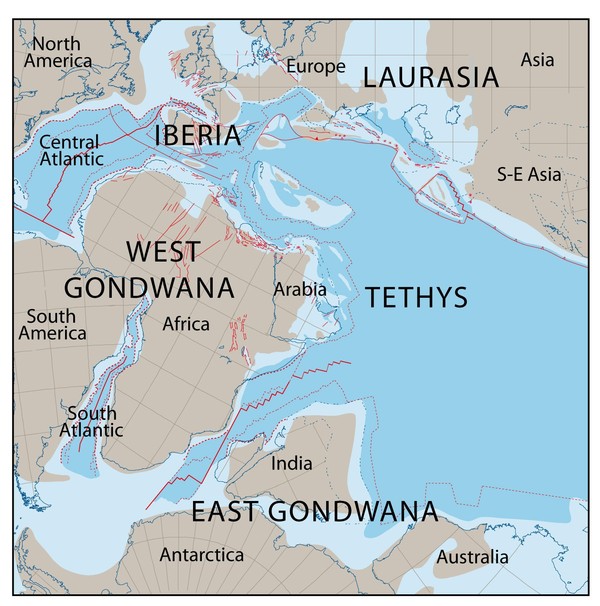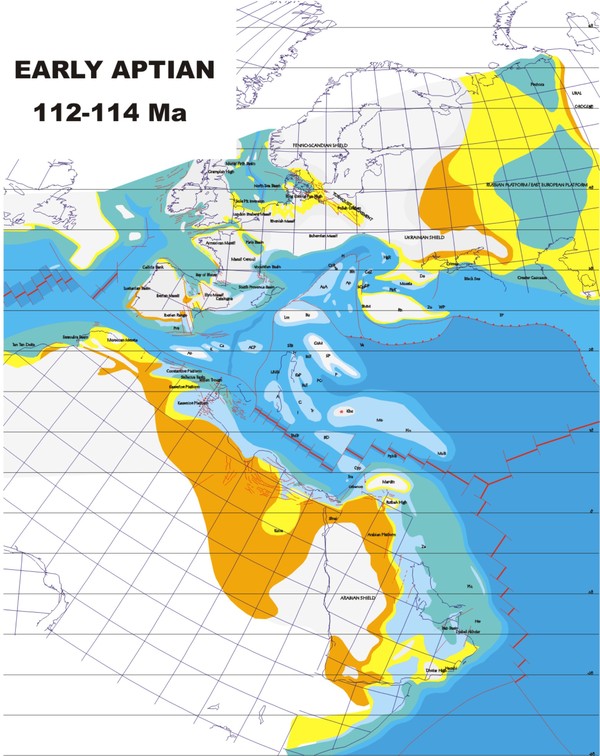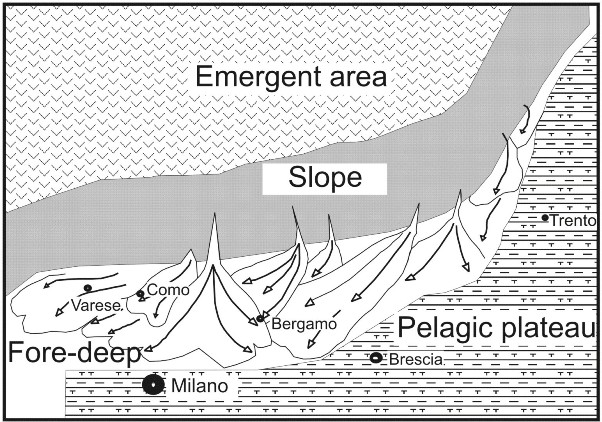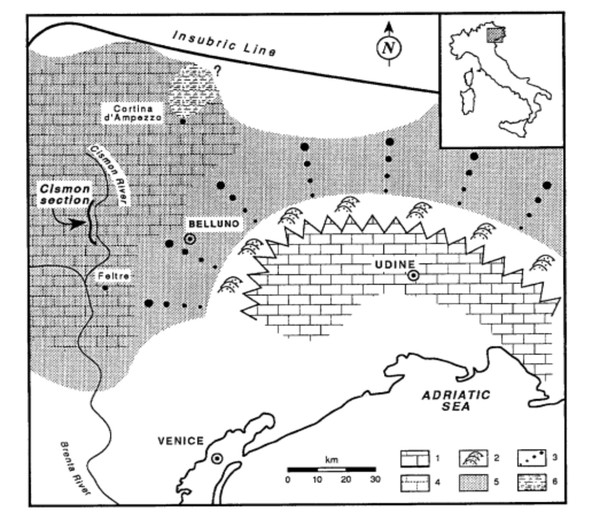The Convergence of Adria toward Europe
The thermal cooling of the Adria margin would have steadily continued for the successive Cretaceous, being controlled by bioproductivity, climate, O2p and CO2p, and oceanic currents, unless new geodynamic events occurred (Figs 58 and 59).
Figure 58. Aptian palaeogeography.

The opening of South Atlantic forced Adria to move northwards to converge and eventually collide with Europe. (from Barrier and Vrielynck, 2008).
Figure 59. Early Aptian palaeogeography.

Also the opening of the eastern Mediterranean forced Adria toward Europe, detaching it from Africa. (From Dercourt et al., 2000).
For the lowest part of the Cretaceous, no new significant events affected the margin of Adria. Since the late Tithonian, the deposition of Maiolica spread on the whole southern alpine margin, but not on the Friuli Platform. This was the actual product of the great increase in the coccolith and nannolith productivity (Erba, 2006) that carpeted all the previous paleogeographic elements. However, the sea floor did not become completely flat. Especially in the Lombardian Basin, some positive topographic features persisted, like the Corni di Canzo swell, where only the Tithonian part of the Maiolica is preserved, and slumped material is accumulated in the nearby deeper marginal part of the Generoso Trough. The carbonate productivity had no significant changes until the earliest Aptian (Erba, 2006, and ref. therein). A significant change in carbonate bioproductivity, with fading of nannoliths, shortly preceded the onsetting of the first of the Cretaceous Anoxic Events that characterized this period, from Aptian to early Turonian.
The new geodynamic event that interfered with this pattern was due to the opening of the Southern Atlantic Ocean. The consequent anticlockwise rotation of Africa pushed Adria to rotate northwards, approaching Europe. This convergence gradually closed the Ligurian-Piedmont Ocean, with subduction obliquely dipping below Adria. Therefore, during the Cretaceous, deformations progressively affected also the Southern Alps. During the Early Cretaceous, the deformation did not involve directly the northern Adria margin cropping out in Southern Alps. However, from the Valanginian onwards, clastic sedimentation reached progressively the Austroalpine domain, presently involved in the alpine nappes in Switzerland and Austria (Wagreich et al., 2008).
On the Southern Alps, terrigenous input originating from the emerging reliefs, linked to the ongoing convergence of Adria and Europe, arrived later. In the Lombardian Basin, the Maiolica is overlaid by the Marna di Bruntino (Aptian-Albian), a succession of marls and splintery, varicoloured shales representing the local evidence of the Anoxic Events OAE1 (Erba, 2004). This unit also contains thin layers of quartzitic arenites led in the deep pelagic environment, often totally anoxic, by feeble tractive currents carrying the first silicoclastic sands originating from the emerging areas to the north.
The definitive turning point occurred since the Cenomanian, when also the northern part of the Lombardian Basin was directly involved by folding (Pizzo Camuno folds; Brack, 1981), and clastic sedimentation occurred in the basin, now mostly E-W oriented. The northern shoulder of this newly oriented basin was also affected by deformation (Bersezio and Fornaciari, 1988). With the Upper Cretaceous, the Adria margin was fully involved in the Eo-Alpine orogeny (Doglioni and Bosellini, 1987; Di Giulio, 1996; Boriani and Giobbi, 2004; Montrasio et al., 2005) (Fig. 60).
Figure 60. The early flysch in Lombardy.

With the emerging of the first relief to the north, a long-shore basin was formed at the foot of the emerging area, in which the turbiditic flows were conveyed. (from Castellarin, 1976, redrawn and modified).
On the Trento Plateau, the Maiolica sedimentation continued, and probably due to the persisting, more elevated sea floor than the surrounding areas, no major silicoclastic input arrived during the Early Cretaceous. Only on the northern margin of the Dolomites in the Val Badia-Ampezzo area (Puez-Ra Stua) some 50–160 m of grey marls, red marly limestone, and occasionally thin quartzarenitic layers crop out above the Maiolica and reddish silty limestones (Cita and Pasquaré, 1959; Baccelle and Lucchi Garavello, 1967; Scudeler Baccelle and Semenza, 1974; Bini et al., 1995; Lukander, 2008). These marls are overlain by a succession in Scaglia facies. Luciani and Cobianchi (1999) distinguished in the Antruiles section a Scaglia Variegata facies of Cenomanian age consisting of burrowed, marly limestone (or sometimes siltstone), marlstone, and calcareous shale, usually black. In turn, they are overlaid by brick-red marl and pink-red pelagic limestone containing in the upper part black, cherty nodules and layers, assigned to the Scaglia Rossa facies (Turonian). Between the two units, a black shale layer is referred to the Bonarelli Level. Bini et al. (1995) mention also calcarenite and conglomerate intercalations, but their age assignment to the Santonian-Maastrichtian was not confirmed by Luciani and Cobianchi (1999).
In the Belluno Basin, the whitish mudstone/wackestone of the Maiolica persisted until the Barremian. From the Aptian, the rain of suspension clay, derived from the ongoing deformations and erosions to the north, together with the biogenic micrite, formed the succession of monotonous white and grey calcareous beds; thin, light-green laminated marls; and marly limestone, organized in couplets and bundles (Bellanca et al., 1996). Within this orbital controlled sedimentation are recorded major anoxic events like the Selli and the Bonarelli Beds (Channel et al., 1979; Bellanca et al., 1996; Erba et al., 1999). At the centre of the basin pelagic sedimentation persisted for the remaining Cretaceous. The Belluno Basin remained in pelagic condition, and the coarser clastic material could not arrive, being situated in the shadow of the topographically more elevated Trento Plateau. On the slope toward the Friuli Platform, bioclastic turbidites are instead interbedded in the pelagic succession (Fig. 61). Their thickness increases eastward of the Piave River to form also resedimented bodies up to 400–500 m (Bellanca et al., 1996).
Figure 61. The terrigenous input reached the northern Dolomites.

During the late Early Cretaceous, the Trento Plateau and its extenson in northern Dolomites were reached by the first terrigenous sediments produced to the north by the convergence of Adria toward Europe. Instead the Belluno Basin remained in pelagic aconditions without terrigenous input, in the shadow of the Trento Plateau. (From Bellanca et al., 1996).
On the Friuli Platform, the carbonate sedimentation continued throughout the whole Early Cretaceous (Venturini, 2002). The resedimented material on the margin of the Belluno Basin testifies to rudist banks growing on the platform rim during the Late Cretaceous (Bosellini and Sarti, 1978). On the internal part of the Friuli Platform, carbonate sediments of the Upper Cretaceous reflect a more open platform environment. Accommodation was significantly reduced to eventually emerge since the Campanian (Venturini, 2002).
In conclusion, the external parts of the Adria margin, what is now the Austroalpine and the northwestern part of the Southern Alps, were directly involved in the Eo-alpine Deformation, while the more internal part of the passive margin, like the Umbria-Marche Basin in the central Apennines, were not directly involved in the deformation, instead only receiving a minor amount of clay to produce the typical sediments of the Scaglia facies.